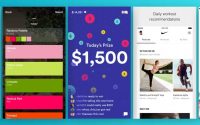29 Growth Hacks To Sky Rocket Your Mobile App!
After developers launch their apps, it’s super frustrating when their work doesn’t immediately and effortlessly skyrocket into the top installed apps or hall of fame. This doesn’t mean that you should lower expectations, but you better know that acquiring new users could get bumpy as well as retaining those who already downloaded the app, especially after the first few days when the hype fades.
Don’t worry about it! In this guide, we’ve rounded up the top 29 growth hacks that you need to follow before, during, and after launching if you want to retain and acquire new users.
1. Create a landing page
Use tools like Unbounce, Wisita, Impact to create a compelling landing page with a brief description of the app and when you will launch. It should showcase sneak peeks of your app features and highlights from your blog. Be specific and include a single call to action to collect e-mails, leads, and test if people are responding to it well or not.
2. Invest heavily in design
Aim your focus on perfecting the features, user interface, and workflow. Use a tool like Apptimize to A/B test your design and figure out which one leads to the highest conversion rates.
3. Shoot an app video
It’s very important to have a compelling video about the app. Use tools like WeVedio, Powtoon, and Raw Shorts to edit your shots or even animate them. Try to be as personal as possible by telling a story to make others relate. Slack did it, so can you!
4. Collect e-mails
In every step of the way, whether you meet people in person or get signups from the landing page, make sure that you collect e-mail addresses as you go to update your leads and send them the latest news about your app features, tips and tricks, and offers. Use tools like Mailchimp and Sumo to streamline the process and reach your target audience.
5. Attend tech conferences
One of the best ways to demo your app is by attending conferences like Dublin Web Summit. Talk to everyone you meet and make sure to prepare a killer pitch and impress.
6. Get your app reviewed
As you approach launching, try to get reviews from various websites like 148Apps, AppAddict, and AppApes for iOS and 101 Best Android Apps, Android App Labs, and Android Central for Android. Not only will the reviews help in enhancing the app, but it will drive exposure and a bigger followers base.
7. Start a blog
Blogging helps with further explaining the app and how a customer can use the product with insights about the industry, as well as showing your team values and culture. It’s a priceless content generation outlet that attracts users and converts them into loyal brand evangelists, in addition to enhancing your internal and external SEO.
8. Prepare white papers and how-to guides
As you develop the blog, transform the best articles you have into extensive how-to guides that can become evergreen and bookmarked by many people. It won’t only add to your reputation, but this will establish you as a thought leader.
9. Include a tutorial on the homepage
Create a simple video using the tools in step three to create a video tutorial explaining how the app is used while highlighting its unique value proposition. It’s different than the teaser video because this one aims to create a user-friendly experience for potential customers by simply and clearly explaining what the app does, without any hints or teasers.
10. Network with the press
Attend events as much as you can and network with anyone you see. You never know who can help out with spreading the word about your new release.
11. Apply for prizes
Enter as many competitions and startup weekends like Disrupt as you can so that you and your app can gain exposure and hype about your release or the new app version.
12. Collaborate with social media influencers
Other than the press and bloggers, social media influencers are great for establishing buzz around your app. It doesn’t have to be Kim K. to successfully work, but you need to look into who sets the trend in each region.
13. Focus on guest blogging
A great way to spread the word is to reach out to other relevant websites and blogs. Make sure to provide useful and original content and never market your app in the blog content itself. If you want to, you could add a brief link referring to the app in your bio at the end of the blog.
14. Drive social media sharing
Whether you are on Facebook or Twitter, engage with your users by posting exciting content. If they like what you post, they’ll share it, reaching more and more quality leads from their social circles. Run contests and give free vouchers or promo codes to those who share/re-tweet the most as an incentive to them.
15. Enhance your SEO
Grade your website by using a tool like QuickSprout to check your website, social media shares, and content. They let you compare yours to other relevant sites to see where you stand. Make sure to update your meta description and follow their advice to rank higher in searches.
16. Use Twitter advanced search
Reaching your key customers could become much easier if you use Twitter advanced search. It includes words, people, places, and dates as well as retweets and mentions.
17. Enhance your Facebook targeting
To refine the quality of leads acquired, focus on targeting similar apps that users liked before.
18. Create SlideShare presentations
With more than 60 million unique users a month, you should create infographics and slide presentations from your original blog content to re-share on SlideShare. You have no idea how much a visual representation of your content increases your leads.
19. Generate promo codes
Whether you are about to launch your app or if you have already launched, offer promotional codes to new and existing users. Display ads on relevant websites, entice users to try your app with a free or discounted code and do the same with your existing users to up-sell or renew their package.
20. Cross promote your app
If you have other apps, promote your newest one through them. This also helps when other complementing apps promote yours. For instance, if you have a photo editing app you can promote it in a video editing app.
21. Provide a lite version
If you have a paid app, create a lite version for people to try out. It could be a simpler, more restrictive version of the app or it could be the same app but supported through ads.
22. Include a reward referral program
Instead of pushing the incentives yourself, let users do it for you. Uber does this by offering discounts to users if they refer their friends. By using a common promo code, both friends get a huge discount and Uber gets to tap into a bigger target market.
23. Optimize for the App Store
Make sure that you have a well-designed icon next to a descriptive name. Your screenshots should showcase your value proposition and help with user onboarding. Try Google keyword planner to test keywords that match your app’s description and the right search queries. Use a tool like AppAnnie to boost your installs and improve your app position.
24. Install analytics
Usemobile analytics tools like flurry and segment.io to track your users and learn insights about their usage patterns and how to optimize for maximum acquisition and retention rates.
25. Communicate with your users
The best way to know what’s working and what’s not is by talking directly with your users and giving them a tool to connect with you directly from within the app. Let them tell you if they need more support or if there’s something not working.
26. Avoid negative reviews
Any ratings below three out of five is a recipe for disaster. That’s why you should pull all your forces towards eliminating any negative feedback. Use a tool like Instabug to track bugs, user steps, crashes, and general feedback from customers.
27. Include push notifications
The style and amount of push notifications can adversely affect your app ratings. Send messages that include promotional material and gentle check-ups. Make it personal and relevant by targeting the messages and make it easy for the users to opt-out if they please.
28. Be cool with your app updates
When Trello updated their iOS version, the first thing they said was, “This update is like holding the future in your hands“. Be creative when announcing a new update or feature. Humor and inspire users so that they get excited about the message you are conveying.
29. Integrate Adwords
Now that you go things going, plan a budget for Adwords. You can target specific devices (iOS or Android) and optimize for mobile searches to get the most out of the money you pay for clicks.
Whenever you try one of these growth hacks, make sure to set up goals and compare your results with specific metrics to know what works with your app and what doesn’t. Iterations will always drive your app install rates and users’ lifetime value.
While growing your app, make sure to check out Instabug. We can help you with user communication, engagement, and retention!
NOW IT’S YOUR TURN: We’d love to hear your growth hacking experiences! Share your thoughts in the comments below.


